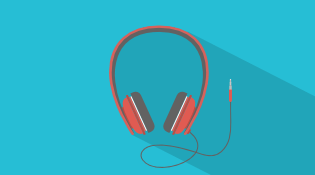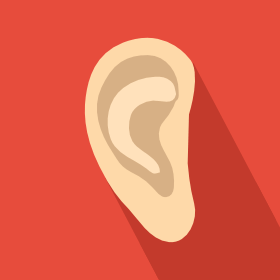
You know how you can instantly sing or hum pretty much any melody you hear?
Somehow, when you hear a tune on the radio, you know exactly how to manipulate your vocal cords to recreate that melody with your voice.
But if I'd hand most guitarists their instrument and ask them to play that same melody by ear, it suddenly seems hard to them. Why is that?

The skill you need in both cases is pretty much the same: listen to something, remember it, reproduce it. The only difference is the tool you're using for that last step. Playing by ear is all about mastering your guitar in the same way you've mastered your voice, allowing you to instantly play (pretty much) any melody you hear in your head.
As you might know, this site is all about developing essential musicianship skills. So in this article I'll show you how to learn to play guitar by ear from scratch. I'll explain how playing by ear works and give you a step-by-step plan to get going. But first, let's tackle some common misconceptions.
Can you learn to play guitar by ear?
People often think playing guitar by ear is something they could never learn. They assume it's some innate talent that you're either born with or not. This is not the case. As with most musical skills, it's all a matter of practice. If you can sing or hum a melody you've heard then you can learn to play it by ear too!
And you don’t have to wait until you ‘become a little bit better at guitar’. You can start developing this skill from the first moment you start learning. (And, for the record, I think you should!) You’ll start using your guitar as an instrument. All it really is, is an object you use to express your musical ideas.
Do you need perfect pitch to play by ear?
Perfect pitch (or absolute pitch) is the ability to hear a pitch and immediately know which note it is. So whether it’s a C, D flat or F sharp etc. It seems to be a something you're born with. You either have perfect pitch or you don't (though some people claim you can learn it).
Whatever the case, having perfect pitch is pretty rare and you don't need it to play by ear or make great music. To drive this point home, here's a little quiz for you. Here are four famous musicians. Which of them have perfect pitch?
 Paul McCartney
Paul McCartney
 Mariah Carey
Mariah Carey
 Freddie Mercury
Freddie Mercury
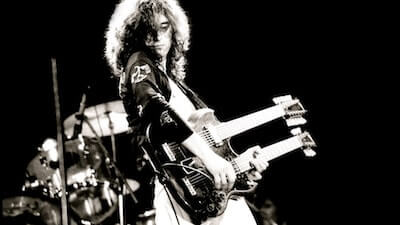 Jimmy Page
Jimmy Page
If you guessed that only Mariah Carey has perfect pitch, you'd be correct. Yes, that means the writers and performers of some of the greatest, most popular songs of all times, including Bohemian Rhapsody, Stairway to Heaven and Let it Be, do not have perfect pitch. In fact, most professional musicians do not have perfect pitch. That includes Eric Clapton, Joni Mitchell, Paul Gilbert, Maurice Ravel, Miles Davis, Stravinsky, David Bowie, Esperenza Spalding, Gwen Stefani, Leonard Bernstein and Carlos Santana. To name just a few.
What all of the above musicians do have though, is called relative pitch: the skill to recreate a note or melody when you get the first note. Relative pitch is about hearing the relationships between pitches, instead of hearing which note an individual pitch is. You could say that perfect pitch is knowing the coordinates of any city. Relative pitch is knowing directions to any city from where you currently are. And this article will show you how to develop relative pitch!
Learn to play guitar by ear step by step
When most of us started to learn the guitar, we learned riffs, licks and other stuff that sounds good and is comfortable to play on guitar. Whether it’s Smoke on the Water, Nothing Else Matters or Seven Nation Army.
The result: the things you know how to play, are the things you've learned on guitar.
But you’ve heard so much more music in your whole life than just the things you’ve learned to play on a guitar. Your brain is filled with musical information and material that you’ve heard in movies, video games, cartoons, television, radio, youtube, Spotify and CDs.
In short: you have a much larger source of music that you can draw on when you're playing.
This step-by-step guide will help you to do exactly that. To recreate all the stuff that’s in your system and that you’re able to sing or hum, but can’t yet play immediately on your guitar.
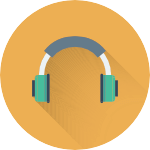
Step 1 - Figure out melodies by ear
If you’ve used tabs and videos to learn songs up until now, the first step is to start figuring out simple melodies by ear on your guitar. This is something you can do even if you’re a complete beginner.
I won’t go into the details here, because you can check out my guide on learning songs and melodies by ear over here. You can also check out my course Make Your Ears Awesome: Kick-Starter that helps you to figure out your first songs by ear using interactive tab. Learning songs by ear is an important first step because it's a bit easier to figure out music that's actually playing than music you hear in your head.
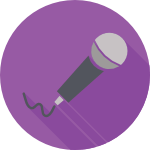
Step 2 - Learn your own Solos
Put on a backing track or play a simple, two chord progression on your guitar. Switch on a recording (your phone will do fine). Tune into the music and wait for a melody to pop into your head. (If nothing does, just relax, don't play anything and give yourself space to hear something. Make sure there's plenty of time for something to develop inside you. It can take a while!)
Sing or hum that ‘solo’ out loud and record it. (Destroy all evidence later if you like). Don’t worry too much about what you sang. It can be anything that comes to mind.
Next, listen back to the recording and figure out how to play your vocal solo on guitar. Try to avoid open strings for now by the way. You're 'programming' the musical logic of the fretboard into your fingers and open strings kind of interfere with that process.
When you've figured out your solo, play along with the recording a couple of times.
This step is how you start accessing all those ideas you've got stored in your head. Of course, there will always be new ideas, but those will often be combinations of old ideas.

Step 3 - Visualise playing something first
Once you’re comfortable with the previous step, you can make things a bit more challenging. Again, take a simple chord progression and sing a melody over it. Make it short and sweet. Anything between three and seven notes is perfect.
Next, all you do is figure out the starting note. Stop there! Don’t try to play the rest of the melody yet. Instead, imagine how you would play that melody on guitar. Visualise which frets you need to press to play it.
Once you have an idea of how you’re supposed to play the short melody, try and see if you got it right. Got it right? Great! Got something wrong? Try to find out why. After a few mistakes, you might notice patterns in what you keep getting wrong.
Keep practicing this until you get better at this. Resist the urge to figure out a melody by trial and error. There's nothing wrong with that, but this exercise trains your musical imagination on a more conscious level. It helps to strengthen the connection between your musical imagination and your fretboard.

Step 4 - Ghost Playing
Put on a backing track. Sing your starting note and find it on your guitar. Next, sing a solo and at the same time lightly touch the corresponding frets on your guitar without actually playing the notes. In other words, don’t use your right hand and don’t pick the notes! I call this 'ghost playing'.
After every couple of notes, check if the notes you’re singing still correspond with the frets you’re ‘ghost playing’ with your left/fretting hand. If you’re doing well, make these sequences longer and longer before you check if you’re still ‘ghost playing’ the correct frets on your guitar.
This step is great because it forces you to sing the notes without having the actual sound of your instrument to support you. You have to imagine them on your own.

Step 5 - The real thing
When you’ve gotten pretty good at the last exercise, it’s time to put everything together and finally play guitar by ear 'for real'. This step is pretty straightforward. Put on some music you like and play whatever you hear. You don’t need to know the key or which scale to use. Just play!

Step 1 - Figure out melodies by ear
If you’ve used tabs and videos to learn songs up until now, the first step is to start figuring out simple melodies by ear on your guitar. This is something you can do even if you’re a complete beginner.
I won’t go into the details here, because you can check out my guide on learning songs and melodies by ear over here. You can also check out my course Make Your Ears Awesome that helps you to figure out 51 songs by ear using interactive tab. Learning songs by ear is an important first step because it's a bit easier to figure out music that's actually playing than music you hear in your head.

Step 2 - Learn your own Solos
Put on a backing track or play a simple, two chord progression on your guitar. Switch on a recording (your phone will do fine). Tune into the music and wait for a melody to pop into your head. (If nothing does, just relax, don't play anything and give yourself space to hear something. Make sure there's plenty of time for something to develop inside you. It can take a while!)
Sing or hum that ‘solo’ out loud and record it. (Destroy all evidence later if you like). Don’t worry too much about what you sang. It can be anything that comes to mind.
Next, listen back to the recording and figure out how to play your vocal solo on guitar. Try to avoid open strings for now by the way. You're 'programming' the musical logic of the fretboard into your fingers and open strings kind of interfere with that process.
When you've figured out your solo, play along with the recording a couple of times.
This step is how you start accessing all those ideas you've got stored in your head. Of course, there will always be new ideas, but those will often be combinations of old ideas.

Step 3 - Visualise playing something first
Once you’re comfortable with the previous step, you can make things a bit more challenging. Again, take a simple chord progression and sing a melody over it. Make it short and sweet. Anything between three and seven notes is perfect.
Next, all you do is figure out the starting note. Stop there! Don’t try to play the rest of the melody yet. Instead, imagine how you would play that melody on guitar. Visualise which frets you need to press to play it.
Once you have an idea of how you’re supposed to play the short melody, try and see if you got it right. Got it right? Great! Got something wrong? Try to find out why. After a few mistakes, you might notice patterns in what you keep getting wrong.
Keep practicing this until you get better at this. Resist the urge to figure out a melody by trial and error. There's nothing wrong with that, but this exercise trains your musical imagination on a more conscious level. It helps to strengthen the connection between your musical imagination and your fretboard.

Step 4 - Ghost Playing
Put on a backing track. Sing your starting note and find it on your guitar. Next, sing a solo and at the same time lightly touch the corresponding frets on your guitar without actually playing the notes. In other words, don’t use your right hand and don’t pick the notes! I call this 'ghost playing'.
After every couple of notes, check if the notes you’re singing still correspond with the frets you’re ‘ghost playing’ with your left/fretting hand. If you’re doing well, make these sequences longer and longer before you check if you’re still ‘ghost playing’ the correct frets on your guitar.
This step is great because it forces you to sing the notes without having the actual sound of your instrument to support you. You have to imagine them on your own.

Step 5 - The real thing
When you’ve gotten pretty good at the last exercise, it’s time to put everything together and finally play guitar by ear 'for real'. This step is pretty straightforward. Put on some music you like and play whatever you hear. You don’t need to know the key or which scale to use. Just play!
It's important to know that you'll still be making mistakes at this step. Mistakes are a good sign. It means that you're not relying on the things you already know how to play, i.e. the stuff that's comfortable and familiar. Instead, when you're making mistakes, it's a sign that you're truly listening to your inner ear, to your musical imagination. As saxophone legend Coleman Hawkins said:
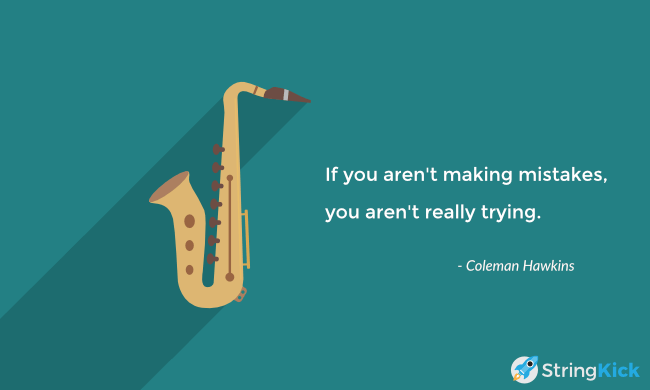
Even the very best musicians make mistakes. But most of the time you wouldn't even notice them, because they've gotten really good at making 'wrong' notes sound 'right' retroactively. Quoting Miles Davis: 'It’s not the note you play that’s the wrong note – it’s the note you play afterwards that makes it right or wrong.' In other words, a huge advantage of being able to play by ear is that you'll get much better at dealing with mistakes and making them not sound as mistakes. So keep messing up and you'll develop this skill too!
Bonus Tip: Free improvisation
The five steps above will help you to develop your playing by ear skills from scratch. As soon as you've gotten half-decent at it, one of the best ways to practice playing by ear is to play freely improvised music. It’s an amazingly fast way to train and streamline the process of:
A. Hearing music B. Coming up with a musical response C. Translating whatever you hear into movements of your hands and playing it
The great thing about playing improvised music is that there's nothing to fall back on. No theoretical knowledge, scales, keys, song forms... All you can do is just listen to the music that's around you and play whatever comes to mind. That's what makes it an incredibly effective way of training your ability to play whatever your inner ear hears.
A year long free improvisation project I did, really drove this point home for me. Over the year, some remarkable things started to happen. My hands were often faster than my thoughts. My fingers would fret the chord I wanted to hear, before I realised I wanted to hear it. There was no time to think of which chord it was or where it was located on the neck. When we switched keys, I’d slide into a new scale effortlessly. Through free improvisation, you learn to trust your intuition. Playing becomes as natural as talking.
In the end, we played two 45-minute shows in which not a single note had been agreed upon beforehand. A year earlier, I would've found that intimidating and scary, but now it was one of the most relaxed shows I'd ever played. I trusted my inner ear would know what to do.
You can easily practice this with a friend. Just have one person play some simple chords, while the other improvises on them without knowing which chords are being played. Just listen to your inner ear and go! When you both feel comfortable with this exercise, you can ditch the chord and solo roles and just play.
What about scales and intervals?
You might have noticed I haven’t mentioned scales so far. That wasn’t an oversight. Of course scales and music theory in general can help you immensely. But the above steps are about developing a more basic ability: to get a subconscious sense of how your hands should manipulate the strings on your fretboard to produce a pitch or melody. A subconscious sense of what happens when you go up or down a string, or when you move up or down the fretboard.
You can learn scales in a way that supports this basic skill and makes it easier. When most people first learn a scale, they are memorising which frets to press. It’s about learning shapes. Some teachers will even say ‘you can play any of these notes and it will sound good!’. If you don’t go beyond this visual stage of learning scales, you’ll sound pretty ‘scaley’ and unnatural.
To strengthen your playing by ear ability, you want to do more than learn shapes on the fretboard. You want to understand how the scale is constructed, so you truly understand those fretboard shapes, and know why they sound the way they do. To do so, you need a solid understanding of intervals as well. To learn everything about intervals and how scales work, check out Music Theory From Scratch, which is of course included in the StringKick All Access Membership.
Collateral Benefits
I prefer to stay away from grand claims. But learning to play by ear is probably the best thing you can do to become a better guitarist and musician. It affects every area of your playing. Timing, sound, note choice, expressiveness...
But perhaps playing by ear has the most profound impact on your self-confidence. By following the steps above, you'll slowly break down the barrier between your head and your hands. More and more, you'll trust that your hands will 'know what to do'.
This is a process I've been going through for the past couple of years. I’m learning to sit back and let my hands do their thing. If I make a mistake, my fingers will slide to correct it instantly. When I’m not sure what the next chord is, my hands will often play it automatically.
Learning to play guitar by ear is about leveraging your subconscious like this. The more you can do that, the more natural your playing will become and the freer you will become.
Get Started Now!
To get you going, I put together some resources to get started easily. This play-guitar-by-ear-bundle contains:
- A mini-course that helps you learn four songs by ear, using interactive tab that provides some hints (which string, first note) to make things easier (and more fun!)
- Links to 19 backing tracks in different styles I recommend for these exercises
- 14 mini-challenges to spark some inspiration for your improvisation if you ever get stuck
Feel free to grab the bundle of playing by ear resources and get started right away :-)
Also, if you want to read more about ear training, check out my Guide to Ear Training for guitar here. Among other things, it will explain why ear training is so important and show you how playing by ear is one of three core musicianship skills. Check it out!
Lastly, consider joining StringKick! In addition to articles like this one, you'll get access to all the courses I've created (about a dozen right now), many of which are all about training your ears, using awesome music (say bye to boring exercises). Find out more about joining here. I'd love to have you on board!
Become an All Access Member
Get access to All Courses and...

Train Your Ears
Ear training should help you in everyday playing. So instead of doing dry exercises, you’ll be figuring out real music by ear. So you’ll develop your ears, while learning tons of cool songs.

Learn Music Theory
Take super practical theory lessons, made specifically for guitar players. They’ll help you to navigate the fretboard, communicate with band mates and understand how the music you love is constructed.
Develop your Musicality
All courses on StringKick focus on tapping into and developing the musician inside you. By strengthening these skills, your playing will start to feel easier and more natural.


![Title image for How to Learn Songs by Ear [Complete Step-by-Step Guide]](https://www.stringkick.com/wp-content/uploads/2015/04/Learn-Songs-By-Ear-Orange.png)
![Title image for How to Improvise On Guitar [Easy Guide]](https://www.stringkick.com/wp-content/uploads/2019/05/Improvise-Purple-315x175.png)
